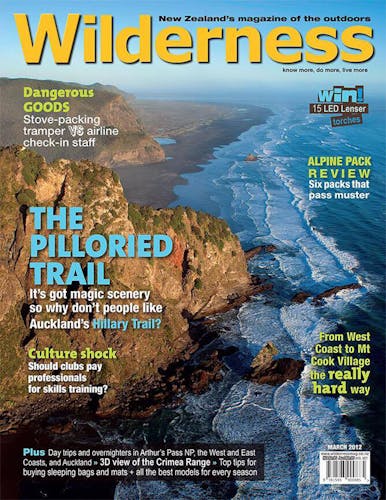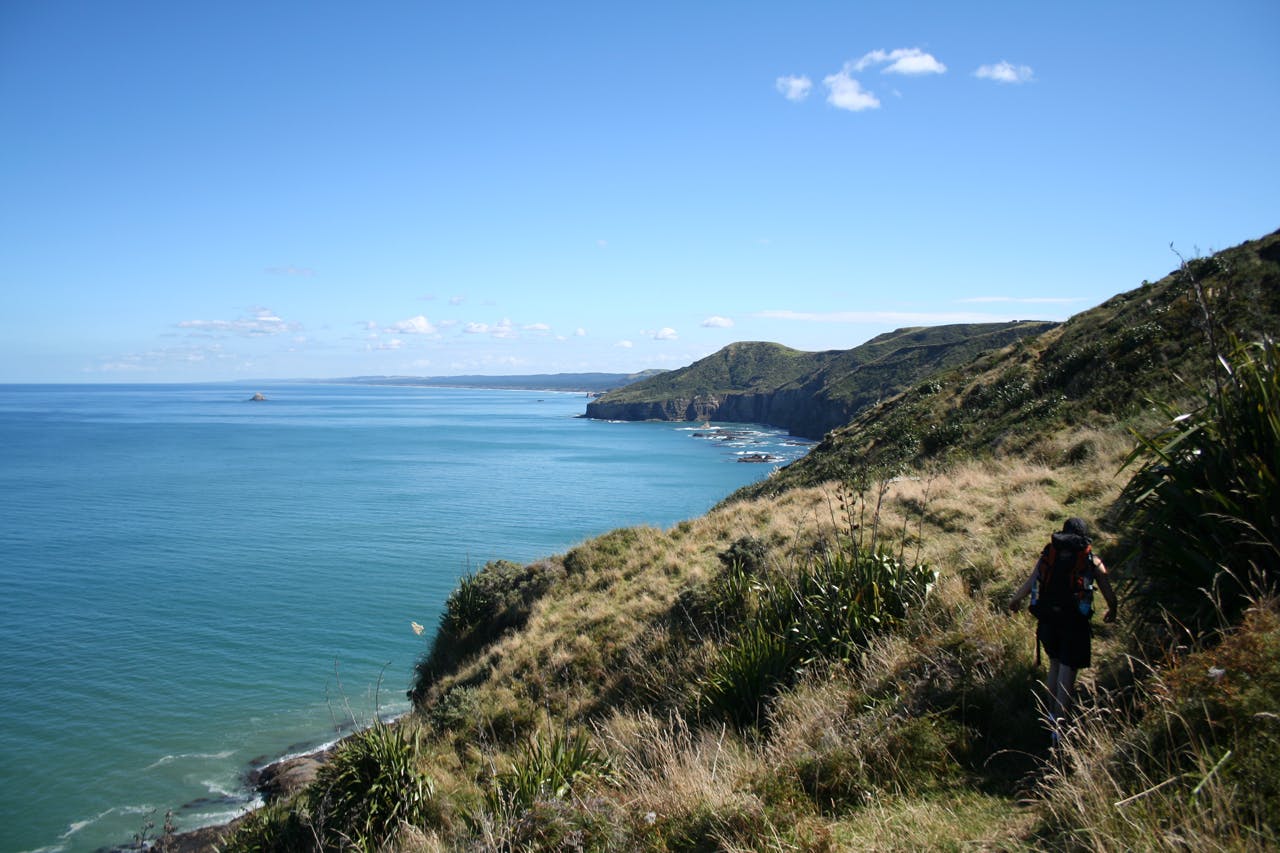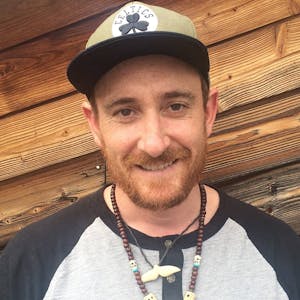Auckland’s Hillary Trail has come under fire for being too tough, poorly maintained and hardly ever walked. Josh Gale laces up his boots to find out what all the fuss is about
It was early afternoon and my mood had begun to resemble the darkening clouds.
Walking barefoot with a 20kg pack, I kept stumbling into low-lying gorse growing on both sides of the foot-wide track.
I’d plugged in my earphones, but even music couldn’t take away my pain.
That morning I’d had to ditch my tramping boots as two of the lace rivets popped out of the left boot while the right was digging into my ankle.
It was only day two of a five day trip of Auckland’s 70km Hillary Trail and I worried how I’d get through without any footwear.
Step-by-step, almost in unison with the clouds above, my mood grew darker and darker.
But as I came out of the bush onto the ridge-top clearing on Omanawanui Track, my spirits lifted.
Before me to the south, the almost ruler-straight coast of Awhitu Peninsula stretched into the distance, to the east the tapered entrance to the Manukau Harbour opened into what seemed a massive lake and to the west the Tasman Sea broke against the sands of desert-like Whatipu Beach.
Views like this, I remembered, are the reward that makes the hardships and mishaps of tramping worthwhile.
At 70km The Hillary Trail is one of the North Island’s longest tramping trails. It compares in length to the 88km Tararua Main Ridge Track and the North-South Track in Kamai Mamaku Forest Park which is 82km. The Heaphy Track, the longest Great Walk in the country, beats the Hillary Trail by a mere 4.5km.
Theoretically speaking, the Hillary Trail could be turned into the country’s second longest Great Walk.
At least that’s what former mayor of Waitakere City Council and Karekare Beach resident Bob Harvey thinks.
However, the former Labour Party president and advertising man, now chair of Waterfront Auckland, is gutted with the current state of the trail which he believes should be at Great Walk standard. He’s disappointed it’s not, saying the trail “is the greatest lost opportunity in the country”.
Last year, at the time of the Rugby World Cup, Harvey said in the media the trail should be “one of the country’s grand international walking trails” and Auckland was missing out on economic returns from it because it’s “locked up”.
Harvey, who’d like to run his own guiding tours on it, believes concessionaires should be allowed to operate on the trail and it should be promoted more effectively so more tourists walk it.
He also proposed starting a trust called ‘Friends of the Hillary Trail’ to raise money for track work.
In January, Harvey and a group of friends walked part of the trail and were disgusted with the mud-ruined state of some sections and because no one else was walking it.
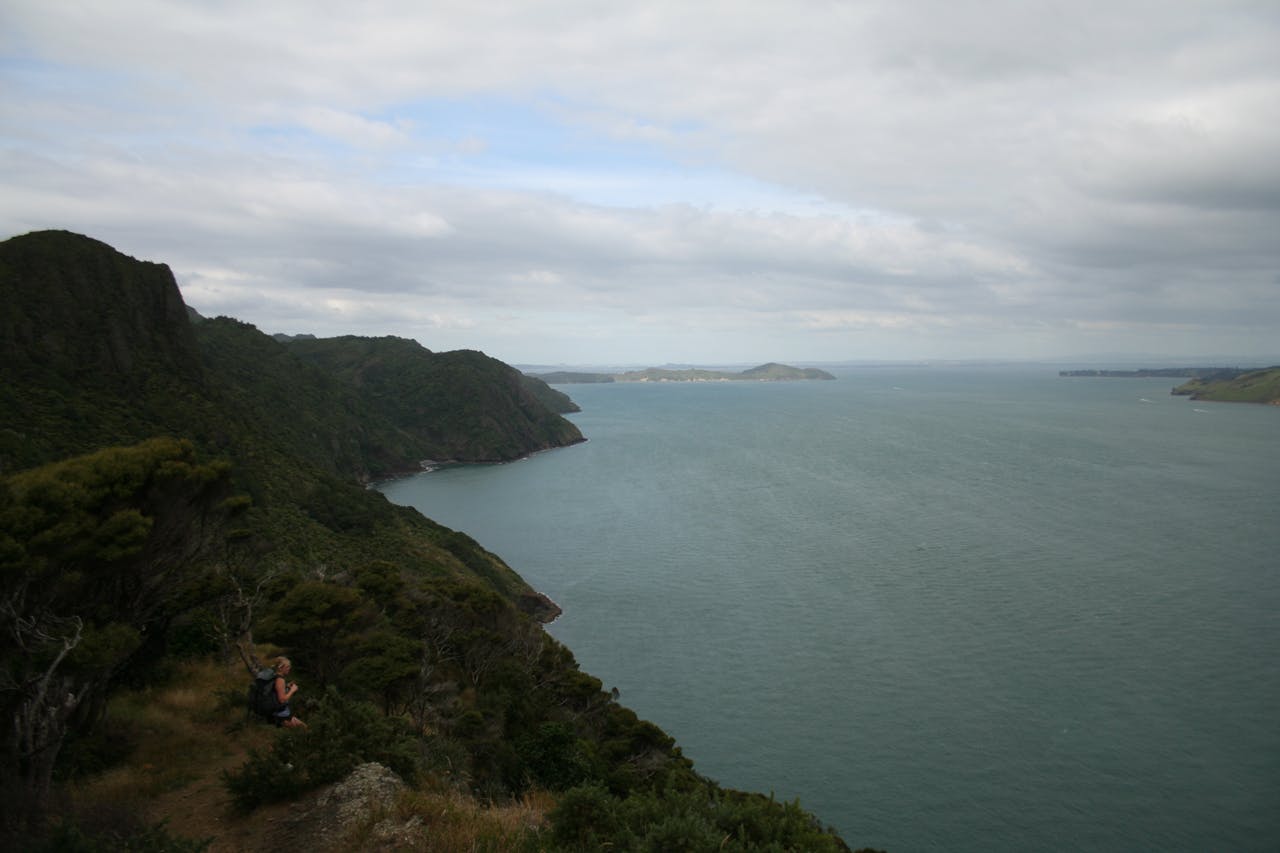
Looking down to O’Neils Beach from the Te Henga Walkway. Photo: Josh Gale
“I thought it was a crime that in the first week of January we were the only people staying in the Whatipu Lodge,” Harvey says. “It’s one of the most prime locations in the country and there’s no one there – what does that say?”
After hearing Harvey’s criticisms of the Hillary Trail I resolved to walk the trail to see for myself.
My wife Juliana and I set out on the Friday before Waitangi Weekend from the Arataki Visitor Centre on Scenic Drive where the Hillary Trail begins.
Auckland Council recommends completing the Hillary Trail in four days, but we decided to take a more leisurely five.
The going was easy from Slip Track at the start to the end of Lower Nihotupu Dam Rd so we made good progress. But then we encountered Hamilton Track.
It’s hard to find the right words to describe it. It is, essentially, two hours of bog, of sloshing through giant mud ponds, clutching at trees and wondering when the torment will end. While “encouraging” Juliana through a mud-induced meltdown, I remembered the fifth circle of hell in Dante’s Inferno in which the fallen fight one another for all eternity while drowning repeatedly in muddy waters. By the time we rose from this hell, our legs were coated and we were exhausted.
A friend who walked Hamilton Track told me she came upon a foreign couple who were nearly in tears because there seemed no end to the suffering.
At the end of our fifth day, it became clear just how much work the Hillary Trail needs. Gorse overgrowth abounds in sections. On the DOC administered Te Henga Coastal Walkway, running from Bethells to Muriwai, we narrowly avoided one hazard after another. Holes perfectly formed for breaking ankles lie in wait concealed by overgrowth. Cliff edge slips require careful negotiation. One group of trail runners said they grasped at gorse to avoid falling.
The week before embarking on our adventure I met up with Waitakere Ranges Regional Parklands principal ranger Steve Bell and ranger Stu Leighton and relayed Harvey’s criticisms of the trail.
I asked them why it isn’t up to Great Walk standard, why it doesn’t offer any huts for accommodation and what’s in-store for the future.
“It’s not a lost opportunity, it’s a developing opportunity,” Leighton said in reply to Harvey’s statement. “The opening of the Hillary Trail in January 2010 wasn’t the end, it was just the beginning.”
Leighton and Bell have no issue with Harvey’s idea of starting a trust; they just don’t understand why he doesn’t talk to them personally rather than make statements in the media.
Leighton says the idea of the Hillary Trail was first raised in the 1970s by rangers who were concerned city folk were losing their outdoor skills and needed a local challenge. But because open fires were the norm back then, the idea was dropped for fear of a blaze ripping through the Waitakere forest.
It wasn’t until 2000 and the increased use of personal cookers that the idea of the trail was raised again.
Leighton and Bell accept there are sections of trail, like Hamilton Track, well below the standard they should be.
They say the opening date of the trail was pushed forward when, in reality, it wasn’t anywhere near finished.
In the coming 24 months they expect work to be done on bringing the tracks up to their original standard, but this will still fall well short of the Great Walk standard.
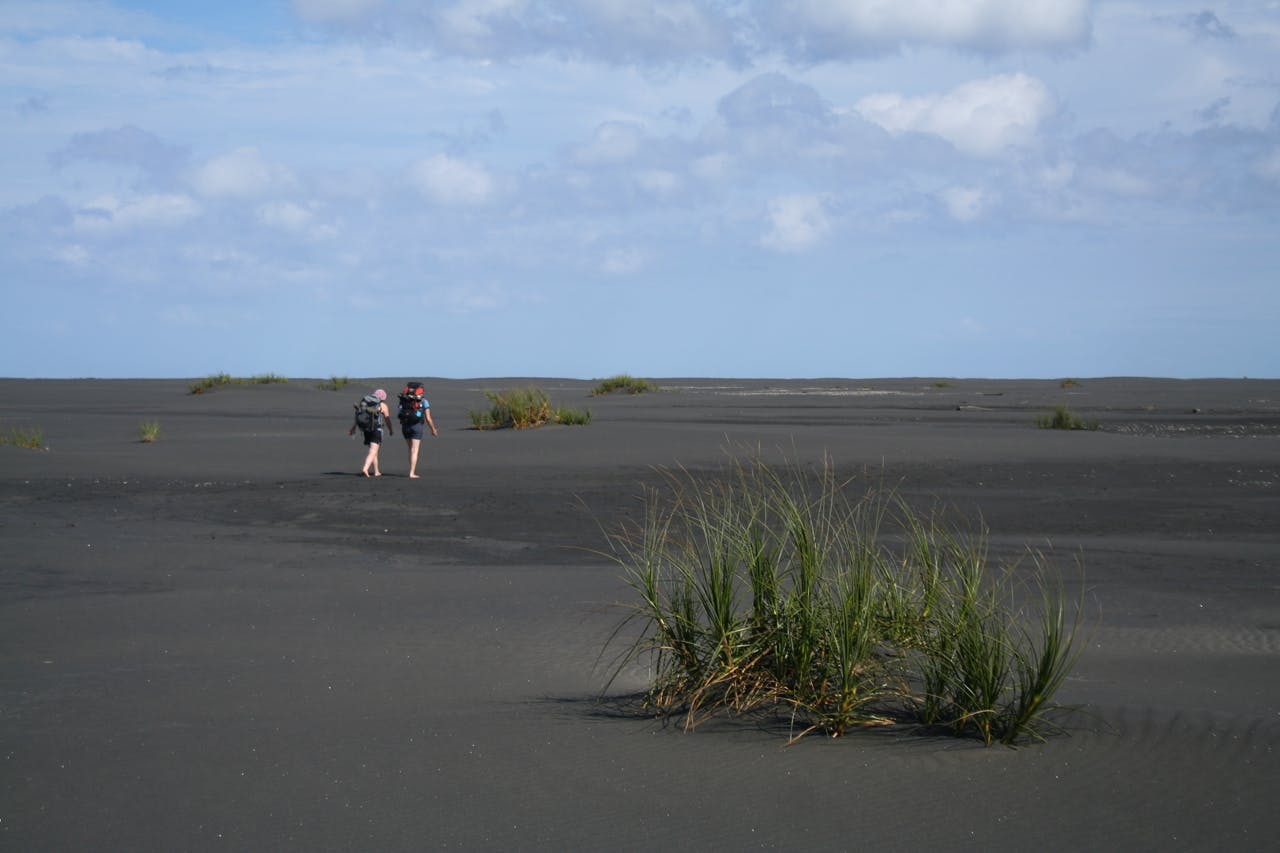
Juliana fights her way through the fifth circle of hell, otherwise known as Hamilton track. Photo: Josh Gale
“The Hillary Trail is a challenge,” Bell says. “The Hillary name in my mind has always been synonymous with a challenge and we don’t want to change that.
“We don’t want to dumb it down and sterilise it so people spend four days walking it and think, ‘gosh that was nice – fabulous, tick, done the Hillary Trail’. We want people to get to the end of it and think, ‘wow, that was tough’.”
This is a noble outlook, but if, as Harvey says, few people walk it then it raises more questions: what use is it if only a handful of people tramp it? And isn’t 70km of rugged coastline tough enough – why make it harder for people?
On our first night, we camped at the Karamatura Farm campground and enjoyed the view of Karamatura Valley as we ate dinner. The following morning, as we set off, we met a group of five also walking the trail from beginning to end.
But they were the only such group we met on our five day trip.
Later, while we ate lunch under the forest canopy at Karamatura Forks, half a dozen middle-aged women jogged around the corner and stopped to chat. We were the first trampers they’d seen, too.
We met a dozen or so trail runners bolting along sections of the trail, but no one walking it from beginning to end – even though it was a long weekend and the weather was, for the most part, fine.
On our fourth and fifth days, from Piha to Bethells and from Bethells to Constable Rd near Muriwai, we didn’t encounter a single person walking the trail, despite stunning weather.
Ranger Stu Leighton, however, says plenty of people do walk it.
“Before we opened the Hillary Trail we never saw anyone up here [Arataki Visitor Centre] with a pack on their back,” he says. “Now it’s a common sight.”
Kids going for their Duke of Edinburgh Gold Award and their instructors walk it regularly, though most only do it in sections, rather than from start to finish.
Auckland Council’s Parks, Recreation and Heritage Forum chair and Piha resident Sandra Coney is fully aware of how challenging the Hillary Trail is.
“It’s pretty hardcore,” she says, laughing. “At the moment you have to swing from tree-to-tree in places.”
Coney isn’t sure how many people walk the Hillary Trail each year though at one point she says 1000 people booked.
This is 6000 less than the estimated number that complete the Tongariro Northern Circuit annually even though the Hillary Trail is just a half hour drive from New Zealand’s largest city.
While making sure the Hillary Trail isn’t ‘watered down’, Auckland Council has other more important reasons it doesn’t want to bring it up to the standard of New Zealand’s Great Walks.
When the idea of the trail was presented to the council in 2005, Coney went to all the committee meetings and got involved in the consultation process. She visited the local communities the trail goes through – Huia, Karekare, Piha and Bethells – to discuss the idea with them.
“The message I got back was they thought it was a good concept, but they were concerned about two things: that the tracks would be elevated to Great Walk standard and they didn’t want it to be a commercialised walk,” Coney says.
Upgrading the tracks to Great Walk standard would cause major environmental impacts such as tree felling, a reduction of canopy cover, allowing weeds to thrive, and an opportunity for Kauri dieback disease to spread, Coney says.
As chair of the parks forum, she is currently under pressure to close areas of the Waitakere Ranges to protect kauri from the deadly disease. Recent studies, she says, have shown the pathogen is moving along the park’s track network.
“I think it’s completely foolhardy to be promoting major track work or increasing numbers going into the Waitakeres while we’re trying to deal this,” Coney says. “At the moment, 11 to 13 per cent of the kauri areas are infected which is a significant increase from our earlier estimates. I don’t think it’s really sunk in with a lot of people.
“We do agree the Hillary Trail is too much for people, that’s why we need shorter sections and more comfortable stays along the route,” Coney says. “It was always intended for there to be an easier trail underneath the hardcore trail.”
As part of its effort to create an easier trail, Auckland Council opened the three-bedroom Craw Homestead at Anawhata to trail walkers in late January. This is one of three cottages the council has opened to make the hutless Hillary Trail more comfortable for people who don’t want to camp.
The council is also looking at opening other baches it owns.

walking barefoot along the striking Whatipu Coast is best done before the black sand heats up. Photo: Josh Gale
“We did look very carefully at huts and we talked to a lot of people in DOC and their advice was to not go near them, but to instead maximise the opportunities in the local communities,” Bell says. “I think it’s important to recognise we can add value to these communities and if we built huts we don’t know whether the demand is going to be there to generate a return or whether it’s just going to be a cost hole.”
Besides the council-owned cottages and campgrounds, there is a range of private accommodation that makes huts unnecessary. In Piha, for example, The Nigel Hanlon Boys Brigade hut is available for hire at $15 a person as well as the Piha Domain campground and chalets and the plush Piha Beachstay Hostel.
Further south, Whatipu Lodge is available, plus a campground and possibly, in the future, another site the council is considering opening.
The major problem, however, is Bethells Beach which at this stage has nowhere for Hillary Trail walkers to stay.
This means the last leg of the walk from Piha to Muriwai is nearly 30km long – a major problem the council is desperate to find a solution for.
The Bethells Beach Cottages can be booked, but cost a couple of hundred dollars more than a backcountry hut. Anna and Jim Wheeler offer luxury tent accommodation in stunning scenery on their property near Lake Wainamu, but the cost is also much higher than a campground or a hut.
Bob Harvey, who’s also President of Surf Life Saving New Zealand, believes Karekare, Piha and Bethells surf life saving clubs could offer their clubrooms as accommodation to Hillary Trail walkers. He says the clubs are cash-strapped and this could provide a good source of revenue for them. I checked out the Bethells Beach club, which already offers its bunk rooms for rent on week nights. After some hassle finding the right person to talk to, the club allowed Juliana and I to stay there. The kitchen was tidy, the bunk rooms with mattresses similar to a backcountry hut and the location, right next to the beach, perfect. However, a lifeguard told me when it rains the building leaks like a sieve so some improvements need to be made.
Coney sees the potential but warns it’s not a quick fix: “Bob has been saying this for a long time, but the surf clubs aren’t leaping up and down saying they want to do it,” she says. “Just because he’s president, he can’t speak for individual clubs on the coast. But maybe it’s a good idea.”
Besides track work, finding land for a campground at Bethells is one of Auckland Council’s main goals for improving the Hillary Trail.
DOC proposed land behind O’Neil’s Beach, but locals opposed it over environmental concerns. Once a campground has been opened, the council will advise walkers to complete the trail in shorter legs to make the trip less gruelling.
At the end of our second day and after washing in the surf, I walked amongst the shifting sand dunes of Whatipu Beach taking photos of the coastlines going north and south.
A handful of surf casters were silhouetted by the low western sun and I approached one to ask if he’d had any luck. Arnaud Boisseau had moved to Auckland from France with his family five years ago for a better lifestyle. We talked as we walked back to the car park and after I tell him about my faulty boots he asks my size. It turns out we’re both size 13 so he lends me his running shoes to get me through the rest of the trail.
After this fortuitous meeting, my mood and the weather mysteriously seem to improve.
Hillary Trail highlights
Ranger Stu Leigton’s top five Hillary Trail highlights:
- Kauri knoll on Hamilton Track This is the first part of the track where walkers can no longer see any infrastructure
- Omanaranui Track Offers views of Manukau Harbour, Whatipu and Awhitu Peninsula and is an enjoyable undulating walk
- Whatipu Coast Sand dunes for as far as the eye can see and powerful surf makes for a striking scene and a great place for photography
- Parahara Valley Track It’s worth spending some time here to take in the Parahara Valley gorge
- Te Henga Coastal Walkway The first half of the walk from Bethells to Muriwai offers views back over O’Neils Beach, Bethells and, on a fine day, as far back as Whatipu Coast. The second half offers cliff-top views north to Muriwai.
Hillary trail tips
After walking the trail, Josh Gale has a few tips for those who plan to do it
- Walk the trail in six, not four, days. This breaks the section down to roughly five to six hour days as follows: Arataki to Huia; Huia to Whatipu; Whatipu to Karekare; Karekare to Piha; Piha to Bethells; Bethells to Constable Rd near Muriwai.
- If you’re short on time, consider skipping the Arataki to Huia section as Hamilton Track is in terrible condition and there’s a fair bit of road walking involved.
- Mosquito repellent is a must at Whatipu and Parahara.
- Reduce pack weight by buying meals at Huia Takeaways, Piha Café (great pizzas) and Bethells Café.
- To avoid the challenging Gibbons-Muir Track, walk the Whatipu Coast all the way to Karekare. Beware, though, sand walking poses its own challenges.
- Take a rest day at Piha where you can get a surfing lesson and relax with beer or wine at the iconic Piha RSA.
- If you’re doing it in a group of four, check out the Wheeler’s very cool luxury tents at Bethells. As group it’s more affordable.
- Finish at Constable Rd rather than Muriwai Beach to avoid road walking.





